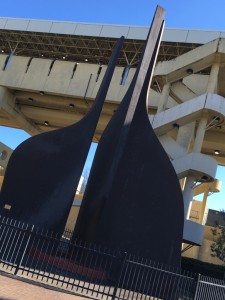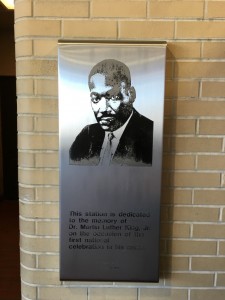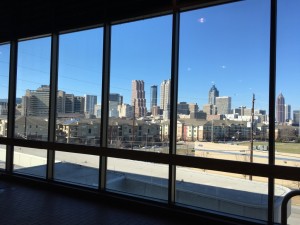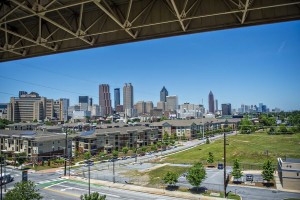 The King Memorial Station is one of the seven Marta stations completed in 1979. The station was built to commemorate the memory of Dr. Martin Luther King, Jr. and the first national holiday in his name. The station is located on Decatur Street SE and is on the blue and green line of the Marta railway. The architecture of the King Memorial station is unique compared to the other station on Marta. The train station is elevated above 21 Memorial Drive, aligned under-passing street were Marta buses and other forms of transportation come and go; the station itself provides protection for waiting passengers from everyday weather, such as rain. The stations is white/grey three stories high and is a combination of round rectangular sections. The building gives off a polished and smooth visual due to its rounded edges and sleek appearance. Upon entering the King Memorial station there are multiple stairs that lead up to the security gates. When enter the through security gates on the second floor, a long panel of glass windows on your right opens up a magnificent view of the city of Atlanta. From this view you would be able to see Grady Memorial Hospital, 191 Peachtree Tower, Promenade II, and most of the popular buildings located in the city. Above that is the third floor were the railway is located. The railway stop is long and wide open to space; a no skateboarding sign is posted near one of walls. The the design of the top floor roof is a triangular pattern of interconnected metal bars, giving way to a lot of natural light being able to come through. Some artifacts present on site worth mentioning is the silver panel with a inscription dedicating the site to Dr. Martin Luther King, Jr. and a huge sculpture located in the front of the train station. Marta classifies this station as a neighborhood station, being home for many Georgia State University students and local residents. Places of interest near the station would the King Memorial, Martin Luther King’s boyhood home, Village Theatre, and Oakland Cemetery. The community surrounding the King Memorial station has gone through a renaissance of sorts in the past few years, being home to a array of new apartments, townhouses, retail shops, and businesses that align themselves on Decatur Street. The station itself and the King Memorial located near it, gives dedication to one of histories greatest civil rights activist, providing travelers a chance to learn about King and achievements. The King Memorial Station itself despite being old, the area around it is every growing and evolving, with new businesses and residents moving in everyday. I predicted that area around the station will soon become a rich and thriving community.
The King Memorial Station is one of the seven Marta stations completed in 1979. The station was built to commemorate the memory of Dr. Martin Luther King, Jr. and the first national holiday in his name. The station is located on Decatur Street SE and is on the blue and green line of the Marta railway. The architecture of the King Memorial station is unique compared to the other station on Marta. The train station is elevated above 21 Memorial Drive, aligned under-passing street were Marta buses and other forms of transportation come and go; the station itself provides protection for waiting passengers from everyday weather, such as rain. The stations is white/grey three stories high and is a combination of round rectangular sections. The building gives off a polished and smooth visual due to its rounded edges and sleek appearance. Upon entering the King Memorial station there are multiple stairs that lead up to the security gates. When enter the through security gates on the second floor, a long panel of glass windows on your right opens up a magnificent view of the city of Atlanta. From this view you would be able to see Grady Memorial Hospital, 191 Peachtree Tower, Promenade II, and most of the popular buildings located in the city. Above that is the third floor were the railway is located. The railway stop is long and wide open to space; a no skateboarding sign is posted near one of walls. The the design of the top floor roof is a triangular pattern of interconnected metal bars, giving way to a lot of natural light being able to come through. Some artifacts present on site worth mentioning is the silver panel with a inscription dedicating the site to Dr. Martin Luther King, Jr. and a huge sculpture located in the front of the train station. Marta classifies this station as a neighborhood station, being home for many Georgia State University students and local residents. Places of interest near the station would the King Memorial, Martin Luther King’s boyhood home, Village Theatre, and Oakland Cemetery. The community surrounding the King Memorial station has gone through a renaissance of sorts in the past few years, being home to a array of new apartments, townhouses, retail shops, and businesses that align themselves on Decatur Street. The station itself and the King Memorial located near it, gives dedication to one of histories greatest civil rights activist, providing travelers a chance to learn about King and achievements. The King Memorial Station itself despite being old, the area around it is every growing and evolving, with new businesses and residents moving in everyday. I predicted that area around the station will soon become a rich and thriving community.
Tag Archives: Unit 1
Exterior Built Environment: Digital Record 6
In front of the King Memorial station to the far right there is a gigantic sculpture situated beside the intersection of Decatur Street and Grant Street. The sculpture is separated into three black metallic panels that transition into a point on top, each is placed centered around a central focal point were the points meet. Behind the sculpture is three fights of winding stairs that is closed of to the regular Marta traveler.
Exterior Built Environment: Digital Record 5
On the third and most top floor of the King Memorial station, is the Marta railway line itself. The King Memorial station railway is on the Marta blue line and is between Georgia state and Inman Park/Reynoldstown station. The railway stop stretches about 500 feet long across the railway. The railway stop is very atmospheric because of how wide and open to space it is. Huge openings on the side and ceilings provide the station with plenty of natural light. The entire ceiling is designed with metal bars interconnected in a triangular pattern providing a place were lights can be installed and a cool architectural feature.
Exterior Built Environment: Digital Record 4
Entering through the security gates into the King Memorial Marta station, on the far back wall their is a small silver panel. On the panel it has a picture of Dr. Martin Luther King, Jr. Below the picture there is exert that says, “This station is dedicated to the memory of Dr. Martin Luther King, Jr. on the occasion of the first national celebration in his name” made by the Marta Board of Directors in January 15, 1986.
Exterior Built Environment: Digital Record 3
When entering the The King Memorial Station, after climbing a couple stairs and through the security gates, on the second floor and left side of the structure; there is a long row of glass paneled windows that provide a beautiful view of the city. This amazing view is what makes the King Memorial so special, because most Marta station, being in there location, cant provide a ariel view of the city like this. Through the windows you could see Grady Memorial Hospital, Bank of America Plaza, Westin Peachtree Plaza Hotel, 191 Peactree Tower, etc.
Exterior Built Environment: Digital Record 2
 The King Memorial Station is built over a street named 21 Memorial Drive. The entire structure itself provides a overpass that is aligned on the entire street. The rode’s purpose is to provide Marta buses and other forms of transportation a place to pick up and drop off their passengers. By designing the building to be on top of this street, it provides protection for the traveler that utilizes the station from everyday weather. It is evident because you can see the aging done by rain on the pillars on the roof.
The King Memorial Station is built over a street named 21 Memorial Drive. The entire structure itself provides a overpass that is aligned on the entire street. The rode’s purpose is to provide Marta buses and other forms of transportation a place to pick up and drop off their passengers. By designing the building to be on top of this street, it provides protection for the traveler that utilizes the station from everyday weather. It is evident because you can see the aging done by rain on the pillars on the roof.
Exterior Built Environment: Digital Record 1
Upon walking up to the King Memorial Marta Station, it is obvious that this particular Marta station is specifically unique compared to other station in metro Atlanta. The building itself is a three story long rectangular building horizontally aligned with the railway of the train. The color of the building is a light cream color along with white accents from panels; the age of the building can be seen from the walls of the structure. The architectural design of the building gives the building a sense of smoothness, through its rounded edges and different symmetrical parts.
Annotated Bibliography 3
Ibes, Dorothy C. “Research Paper: A Multi-Dimensional Classification And Equity Analysis Of An Urban Park System: A Novel Methodology And Case Study Application.”Landscape And Urban Planning 137.(2015): 122-137.ScienceDirect. Web. 5 Feb. 2016.
In Dorothy Ibes study, she analysis parks according to their physical, land cover, and built features. The parks in study are then evaluated for equity, comparing certain park types to neighborhood social characteristics, statistically and spatially. The studies result in five distinct park types; Suburban Amenity Parks, Green Mini Parks, Native Desert Preserves, Green Neighborhood Parks, and Urban Core Parks. Each type of park details a unique mix of built characteristics. The study reveals that there is relevant measure of park equity by comparing park types with neighborhood social dimensions, exposing who has access to what kind of parks. From the results of the study, it calls for a social and geographical integration when access urban parks. The research provides future knowledge helpful for equitable urban park planning, policy, and management. Ibes studies, urge future studies to use these mixed methods to investigate the multiple dimensions of complex urban park systems, to transform under-appreciated spaces to drivers that push for more livable and sustainable cities.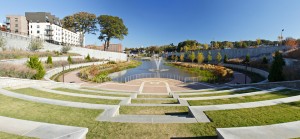
I chose this source because in relates to the the discussion architectural exclusion in relation to urban parks. the only flaw in this article would be that Dorothy Ibes only points out the exclusion of parks in certain parts of urban communities but does not elaborate on why parks are a benefit to urban cities.
Annotated Bibliography 2
Ha, Yoonsook, et al. “Barriers And Facilitators To Shelter Utilization Among Homeless Young Adults.” Evaluation And Program Planning 53.(2015): 25-33. ScienceDirect. Web. 5 Feb. 2016.
Yoonsook Ha studies the utilization of shelters among homeless young adults in large urban cities in the southwest region of America. Through his studies, Yoonsook discovered that there are many common barriers to the utilization of shelters. Personal barriers that prevent the youth from seeking shelters include sense of pride, independence, or self-reliance. Agency-related barriers include restrictive rules, location, and lack of identification or transportation to use services. The young adults who are able to enter the shelters, they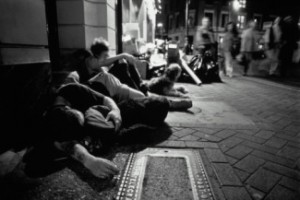 face negative staff attributes and relationships, health and safety issues, and other structural issues. Many youths describe initial reluctance to seek shelter, but they are motivated to turn their lives around to be a better person and start over to succeed. This gives reason for a motive to improve the conditions of shelters to accommodate to homeless youth in the streets of urban cities. Yoonsook concludes his studies by focusing on homeless young adults, the study will provide an in-depth understanding of specific needs and circumstances that homeless young adults face.
face negative staff attributes and relationships, health and safety issues, and other structural issues. Many youths describe initial reluctance to seek shelter, but they are motivated to turn their lives around to be a better person and start over to succeed. This gives reason for a motive to improve the conditions of shelters to accommodate to homeless youth in the streets of urban cities. Yoonsook concludes his studies by focusing on homeless young adults, the study will provide an in-depth understanding of specific needs and circumstances that homeless young adults face.
I chose this source because it was relevant to one of the readings we discussed in class relating to Irina Nersessova’s Tapestry of Space: Domestic Architecture and Underground Communities in Margaret Morton’s Photography of a Forgotten New York. This source provides a alternative view point, in the perspective of the homeless youth.
Annotated Bibliography 1
Alderman, Derek H. “New Memorial Landscapes In The American South.” Professional Geographer 52.4 (2000): 658.Advanced Placement Source. Web. 5 Feb. 2016.
Derek Alderman in his analysis of monument, memorials, shrines, museums, preserved sites, and other places used to commemorate and sanctify the past in the American South. His research underlies three central concepts. First, memorial landscapes must be judged by the people to be worthy and agreed by others to be commemorated and sanctified. Second, the geographical location of memorial sites influences public views of the past. Finally, memorial landscapes are constantly shifting as government, population, and culture grows and develops. Alderman gives examples of streets named after MLK. He explains how, even though these streets were named to commemorate the great civil rights leader, these streets often reinforce traditional social and economic boundaries in the city. It is this example that contributes to Alderman’s common theme of his article; while memorial landscapes shape how the public views and values the past, they also reveal a great deal about the interests, concerns and choices of those in the present.
three central concepts. First, memorial landscapes must be judged by the people to be worthy and agreed by others to be commemorated and sanctified. Second, the geographical location of memorial sites influences public views of the past. Finally, memorial landscapes are constantly shifting as government, population, and culture grows and develops. Alderman gives examples of streets named after MLK. He explains how, even though these streets were named to commemorate the great civil rights leader, these streets often reinforce traditional social and economic boundaries in the city. It is this example that contributes to Alderman’s common theme of his article; while memorial landscapes shape how the public views and values the past, they also reveal a great deal about the interests, concerns and choices of those in the present.
I chose this source because it relates to my exterior built environment location, the MLK memorial station on MARTA. I wanted to learn how memorial sites are important to ones community and how people view them.
